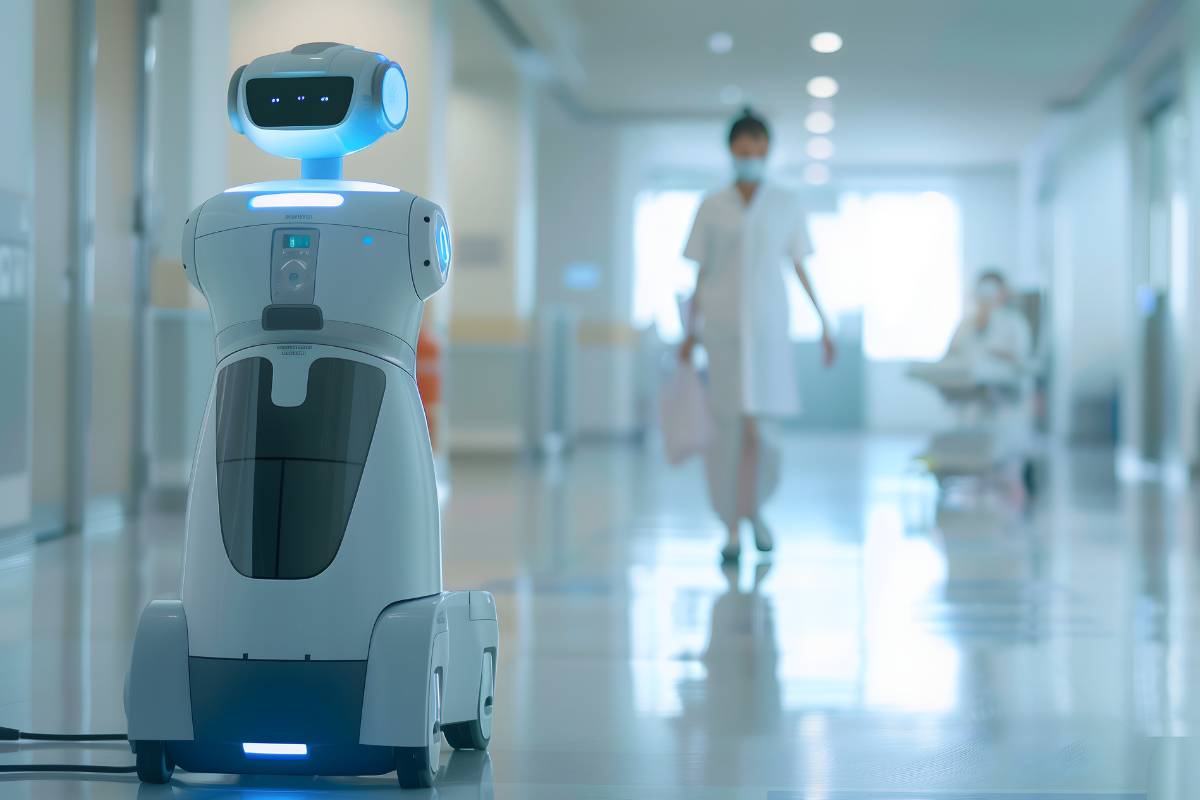What Is a Robot Nurse? Advantages and Disadvantages of AI in Healthcare

How many times have you been asked to do a task at work that detracts from your role as a clinician? Whether it’s picking up delivery food for patients, running medications to or from the pharmacy, or dropping off blood samples, tiny non-clinical tasks can add up to a hectic shift. A robot nurse could help with these duties, and many facilities are already using robotic technology in patient care.
While awareness (and concern) about tech in healthcare has grown in recent years, robotic and AI-assisted medical devices aren’t new. Tools like these have been used in medicine, nursing, and healthcare for over a decade. One of the first studies of nursing robotics, published in 2002, used a bot named Pearl to assist elderly patients with using the bathroom, eating, and other tasks.
So, what should you know about nurse robot tech? Let’s talk about the benefits and drawbacks of AI and robotics in healthcare.
What Is a Robot Nurse?
The term robot nurse is a misnomer because no current robotic or AI technology can match the scope of tasks and emotional intelligence that human nurses provide daily. Instead, robotics are being developed and used to reduce administrative and logistical tasks for nurses. For example, a robot nurse in a hospital might be able to help transport documents or deliver medications to a unit, but there isn’t currently a robot that can insert a Foley catheter.
Robotics in healthcare typically aims to support nurses, reduce burnout, and free up time for patient care. The demand for such support is only going to increase. The nursing shortage is projected to grow to 10 million by 2030, and meanwhile, the global population of adults 60 and over will nearly double by 2050.
To address this shortage and need for care, tech companies are coming up with solutions like robotics and AI assistance for nurses. However, patient-centered care remains inherently human, and technology is a tool rather than a substitute for real nurses.
What Tasks Can Robotic Nurses Do?

Robots can help nurses with high-repetition, low-risk tasks and improve quality and safety for patients. Here are some ways that AI and robotics assist in healthcare delivery:
- Robotic-assisted surgeries: Robots like the Da Vinci system enhance precision in complex procedures.
- AI-assisted diagnostic tools: AI algorithms help read medical imaging, such as X-rays and MRIs.
- Automated medication dispensing: Robots and software manage medication distribution to reduce errors.
- AI voice transcription software: Clinicians can complete documentation by converting spoken words into text.
- Transportation robots: Nursing assistant devices like Moxi deliver supplies or transport samples around hospitals.
- Telemedicine and virtual nursing assistants: AI-powered chatbots assist with patient triage and routine inquiries.
Potential Benefits of Robotic Nurses
Reduction in Nurse Burnout
The primary goals of nursing assistant robots are to reduce the workload on human nurses and keep patients safe. Hopefully, this tech can help ease burnout by taking over routine activities like documentation and box-checking. This may free nurses up for more essential, patient-facing tasks.
Increased Efficiency
Since robots don’t have human needs — one hospital robot can work 22-hour shifts with ease — they can increase overall efficiency. Ideally, this technology can streamline hospital workflows and make sure supplies reach patients promptly. This efficiency could reduce human error and ensure a smoother healthcare environment.
Infection Control and Lessening Staff Exposure
Robots can serve patients without direct human interaction, minimizing staff exposure to infectious diseases like methicillin-resistant staphylococcus aureus (MRSA), COVID-19, and the flu. When fewer staff members get sick, units and facilities can maintain better patient-safety ratios.
Tech Innovations
The more that AI and robotic tech are used in medicine, the more developers can learn about their potential. Robot nurses in the future may be able to perform additional tasks, such as monitoring patients who present with a high fall risk or doing documentation for nurses.
Disadvantages and Concerns About Robotic Nurses
Robots Lack Nursing Judgment
AI systems still lack the ability to offer clinical judgment and adaptability — traits that are critical in nursing practice. For example, a nurse robot can’t have a gut feeling about a patient’s status the way that an experienced nurse can.
Limited Emotional Interaction
Robots can simulate empathy or emotional support, but they can’t have a human experience. Patients may find that the support and dialogue that a robot nurse offers is hollow, lacking a human-to-human connection. Additionally, robots may worsen confusion in patients who are already experiencing delirium or dementia.
Technological Limitations and Troubleshooting
Although AI is advancing, robot nurses can still struggle with complex tasks or decisions. They are primarily effective in predictable, structured environments, and they require human oversight. These systems will inevitably need troubleshooting. Will nurses be responsible for managing their robot assistants, along with the hundreds of other tasks they have in a shift? Only time will tell.
Robot Nurses: FAQs
Will nurses be replaced by robots?
Not likely. That’s because nurses have skills that AI-assisted robots don’t, such as:
- Critical thinking and decision-making: Nurses make on-the-spot clinical decisions, especially in emergencies, which AI cannot fully replicate.
- Emotional support and empathy: Providing compassion to patients and families requires human understanding and presence that robots cannot offer. AI models can replicate emotional intelligence, but they can’t truly possess it.
- Adaptability in unpredictable situations: Nurses must respond to evolving patient needs and unexpected challenges that are beyond the scope of AI algorithms.
- Ethical judgment: Many nursing decisions involve moral considerations that require more than data-driven logic.
- Hands-on skills: Tasks such as wound care, IV insertions, and Foley maintenance require precision and sensitivity that robots don’t have.
How much does a robot nurse cost?
The cost of this technology depends on the model and how it’s used. One nursing robotic assistant has a startup cost of about $22,000, with monthly costs of about $11,625. For some comparison, when a nurse leaves, replacing them costs an average of $56,300 per nurse. So if systems like this can mitigate turnover rates and keep patients safe, the investment may be worthwhile.
Who is responsible if AI goes wrong in healthcare?
Determining responsibility for tech failures is complex. If using a robotic nurse or AI program contributes to patient harm, who is liable? Here’s what you can do to protect your license while using robot assistants:
- Document thoroughly: Record any delegations to AI and robotic systems, and how the patient responded if applicable.
- Stay updated on training: Ensure you receive regular education on AI tools integrated into your unit, so you’re not using them outside their scope.
- Use clinical judgment: Treat AI as a tool, not a replacement. Trust your expertise when patient care decisions conflict with technology recommendations.
- Understand policies: Familiarize yourself with your facility’s guidelines on AI use and liability protocols.
Find Jobs for Human Nurses
No robot nurse can do what you do. If you’re looking for a new opportunity, IntelyCare can help match you with the perfect role. Learn more today.



